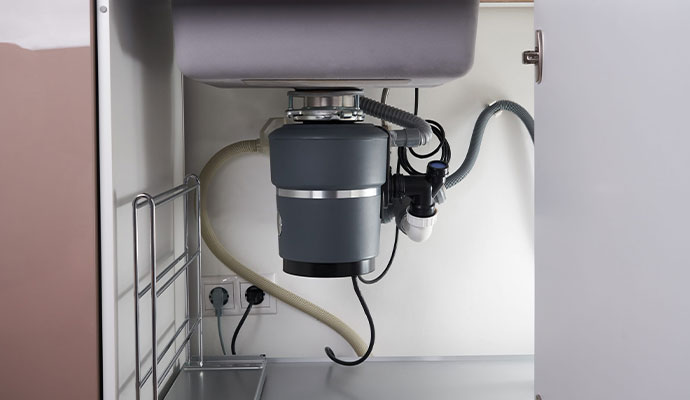What are your insights and beliefs on How to fix a pretty consistent leak from my garbage disposal?

Garbage disposals are essential kitchen area appliances that aid in throwing away food waste successfully. Nonetheless, a leaking garbage disposal can be an irritating and messy issue to handle. Luckily, lots of leaks can be repaired easily with a few basic actions. In this post, we will talk about how to repair a dripping garbage disposal properly.
Intro
Garbage disposals are set up under kitchen area sinks and are designed to shred food waste right into smaller sized items, enabling it to pass through the pipes system quickly. While these devices are typically reliable, leakages can occur in time due to deterioration, loosened connections, or damage to the unit.
Usual Sources Of Leakages in Rubbish Disposals
Worn Seals and Gaskets
Seals and gaskets play an essential role in avoiding water from dripping out of the garbage disposal. Gradually, these elements can wear away, resulting in leaks around the disposal system.
Loose Connections
The links in between the garbage disposal and the pipes system can end up being loose over time, causing water to leak out throughout operation.
Fractures or Holes in the Disposal Device
Physical damages to the garbage disposal, such as cracks or openings in the real estate, can also lead to leaks.
Recognizing the Resource of the Leakage
Before attempting to take care of a dripping waste disposal unit, it is important to recognize the source of the leakage. This can generally be done through visual assessment or by conducting basic tests.
Visual Assessment
Inspect the waste disposal unit device meticulously for any indicators of water leakage. Pay attention to locations around seals, gaskets, and link points.
Evaluating for Leakages
One way to evaluate for leakages is by running water through the disposal unit and checking for any kind of visible indications of leakage.
Devices and Materials Needed for Repairing a Dripping Garbage Disposal
Prior to beginning the repair process, collect the essential devices and materials, consisting of a screwdriver, flexible wrench, plumbing technician's putty, replacement seals or gaskets, and epoxy or patching material for repairing fractures or holes.
Step-by-Step Overview to Fixing a Leaking Waste Disposal Unit
Turn Off the Power
Prior to trying any repairs, ensure that the power to the waste disposal unit unit is turned off to avoid the risk of electric shock.
Locate the Leak
Recognize the precise area of the leak and establish the cause.
Tighten Links
Use a wrench to tighten any kind of loosened connections between the disposal device and the pipes system.
Change Seals or Gaskets
If the leak is due to worn seals or gaskets, get rid of the old parts and change them with new ones.
Patching Splits or Holes
For cracks or holes in the disposal unit, use epoxy or an appropriate patching material to secure the damaged location.
Examining the Garbage Disposal After Repair Work
As soon as the repair is full, evaluate the waste disposal unit by running water via it to guarantee that the leak has been solved.
Preventive Maintenance Tips to Stay Clear Of Future Leakages
To avoid future leaks, it is vital to execute regular upkeep on your garbage disposal. This consists of maintaining it tidy, preventing putting non-food things or hard objects down the disposal, and occasionally looking for leaks or various other problems.
Conclusion
To conclude, fixing a dripping waste disposal unit is a fairly uncomplicated procedure that can be finished with basic tools and products. By following the actions described in this write-up and practicing preventive upkeep, you can maintain your waste disposal unit in good working condition and stay clear of costly repair work in the future.
HERE’S HOW TO FIX YOUR GARBAGE DISPOSAL
WHAT TO DO IF SOMETHING IS STUCK IN YOUR GARBAGE DISPOSAL
If the impeller won’t turn, there’s probably something stuck in the disposal. It could be a steak bone or peach pit, although plumbers report pulling all sorts of inappropriate objects out of disposals, such as bottle caps or aluminum foil. Make sure power to the disposal is off, and look inside to see if you can see the source of the jam.
Never stick your fingers in a disposal. Pull out anything you see with tongs or pliers.
If the disposal still won’t work, it may be time to call a plumber or consider buying a new disposal. GEM Plumbing & Heating is here for all of your garbage disposal needs.
WHAT TO DO IF YOUR GARBAGE DISPOSAL DRAIN IS CLOGGED
Take everything out from underneath your sink and put a bucket or other container under your disposal to catch any water that drains out. Disconnect your disposal from the power supply. If it’s plugged into a wall outlet, unplug it. If it’s hardwired into an electrical box, go to the electrical panel and turn off the breaker for the disposal. Pour ¼ cup of baking soda into the drain, followed by ½ cup of white vinegar. Give the solution a few minutes to fizz and do its work. Look into the disposal with a flashlight to see if you can see an object that might be causing the clog. If you see it, remove it using tongs or pliers. MORE TIPS ON DEALING WITH A CLOGGED GARBAGE DISPOSAL
Never use drain cleaner in a garbage disposal. It can damage the plastic parts inside the disposal. You can also be splashed with the caustic liquid while working to clear the clog. Beware! Never stick your fingers into a garbage disposal. Trust us — not a good idea. In many instances, your dishwasher drains through your garbage disposal. This allows the disposal to grind any large food particles that may be drained out of your dishwasher. There are some jurisdictions, however, where the plumbing code prohibits such a connection. WHAT TO DO WHEN YOUR DISHWASHER DRAINS THROUGH THE DISPOSAL
Run some water in the sink so your plunger has at least a ½-inch of water to create a seal and plunge vigorously up and down several times. You may need to repeat this several times. Run hot water down the drain to clear any residue that remains.

We hope you enjoyed our article on Why Is My Garbage Disposal Leaking From the Bottom?. Many thanks for taking a few minutes to read our piece. If you enjoyed reading our article kindly remember to share it. Thanks so much for taking the time to read it.
Call Today